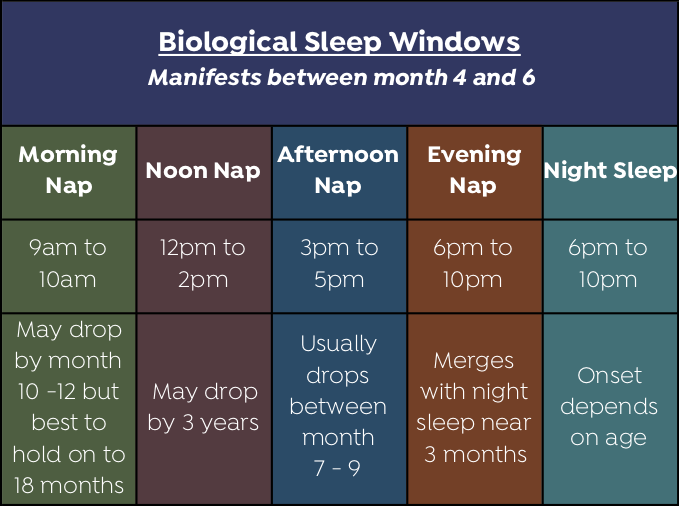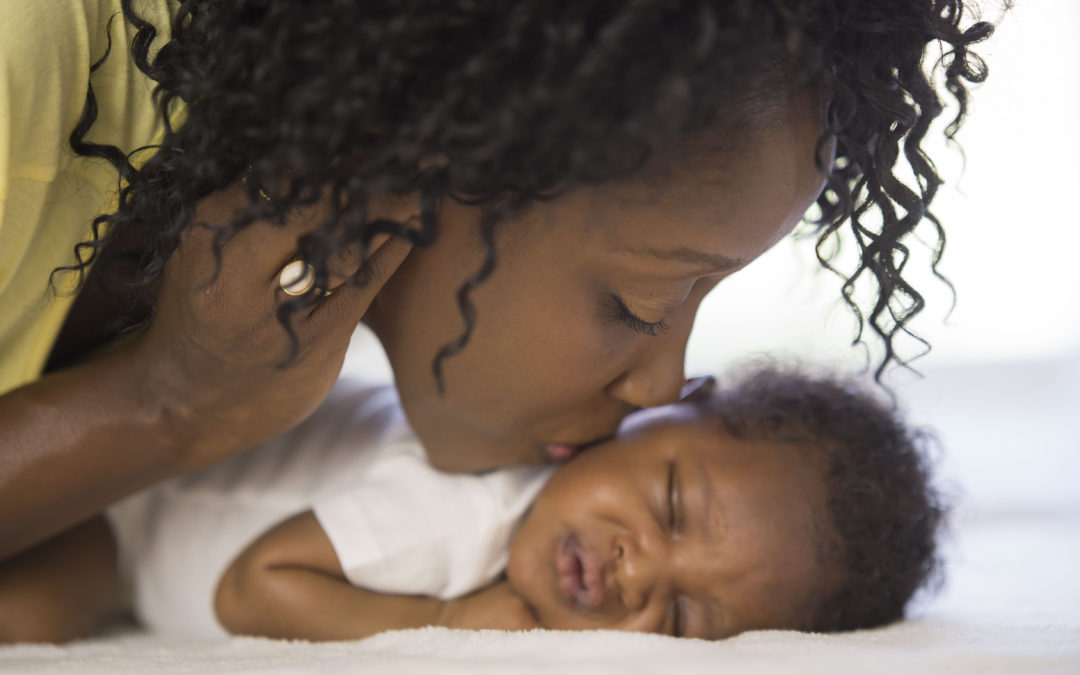Many parents wonder when the best time is to put their little ones to sleep. It turns out there are, and they are called Biological Sleep Windows! Biological Sleep Windows are times of day when almost all babies begin their naps and go to bed for the night. They begin to appear around the sixth week after a baby’s due date, gain traction around the 4th month, and solidify by the six month. Understanding why they develop and how to maximize their helpfulness is key to supporting babies in their sleep.
Babies are born with multiple underdeveloped systems that develop over time, one of those systems being the Circadian Rhythm. The circadian rhythm is a complex system that regulates sleep through the release and conversion of hormones within the body. This system controls four biological rhythms known to affect sleep: sleep/awake cycle, body temperature fluctuations, cortisol secretion, and melatonin/serotonin secretion and conversion. In the early months an infant will sleep whenever tired without any internal sense of day and night and the biological rhythms do not necessarily dance in harmony. The biological rhythms begin to show synchronicity around the fourth month indicating that the Circadian Rhythm is coming on line. This process is usually complete for most babies by the 6th month.
The Circadian Rhythm’s main job is to provide a uniform and healthy experience of sleep. As it becomes operational, babies begin to trend towards regular nap and bedtimes and show a need for consistent sleep time opportunities to allow the Circadian Rhythm to perform its function of regulating sleep. Many times, parents, unaware that their baby’s body has developed the need for regular naps times, miss providing the consistent sleep opportunities their babies need to have a healthy sleeping experience. Many parents see their baby’s sleep begin to degenerate around the fourth and fifth month and wonder what is going on. While there are multiple factors to a baby’s sleep becoming difficult around this time (more information here) knowing a bit about a baby’s Biological Sleep Windows can be very helpful.
Biological Sleep Windows are times of the day when babies show a predisposition to go to sleep. These windows do not represent the average time asleep for a nap but rather the span of time most babies go to sleep for a nap or for the night. The graphic provided shows the progression of Biological Sleep Windows beginning around the sixth week post due date and concluding to the end of the last nap.

Newborns: night sleep begins around 10pm and drifts earlier until it reaches 6:30/7pm by the fourth month. Some infants will go to sleep at 6pm before the fourth month but this is technically a nap and the biological characteristics of night sleep occur later in the evening. Many babies tank up for the night between 6 and 10pm, taking short sleeps between. To account for the varying spans of when babies appear to go to sleep for the night, the provided graphic shows a window between 6 and 10pm. After the fourth month 7pm is too late for a bedtime. It is a good practice to think of bedtime as 6/6:30pm for a newborn but do not be surprised if your baby wakes to feed.
Infants: Near the fourth month the morning nap emerges with a window beginning near 9am and the noon nap beginning near 12pm. The morning nap is biologically a continuation of night sleep consisting of lots of REM sleep while the noon nap consists of deeper levels of sleep and is thus more restorative . A late afternoon nap or two develop beginning near 3pm out of need to form a bridge to the night sleep window that has by this time drifted to around 6:30/7pm. Some babies will take two shorter naps in the late afternoon instead of one longer one. The late afternoon nap typically drops between the seventh and ninth month.
Infants/Toddlers: Most babies keep a morning nap beyond the first year but some drop them as early as the tenth month. My guess is these babies are not getting good rest and as a result drop naps early. I often work with parents whose child has dropped a nap early who find that adjusting to an earlier bedtime and offering a nap within the Biological Sleep Window brings the nap back and their child is better rested. It is best to hold onto the morning nap to the eighteenth month. Some babies appear to drop the noon nap before three years of age but this is usually traceable to a child being overtired and inconsistent nap opportunities. It is also helpful to shorten the length of the noon nap by starting the nap later and keeping the same wake up time.
When considering sleep timing for our little ones, having an understanding of baby sleep development as expressed through the Biological Sleep Windows is a useful tool in understanding supportive timing for naps and bedtime. Structuring sleep around these windows is helpful to babies, as doing so allows the Circadian Rhythm to do its job of creating restorative sleep.

